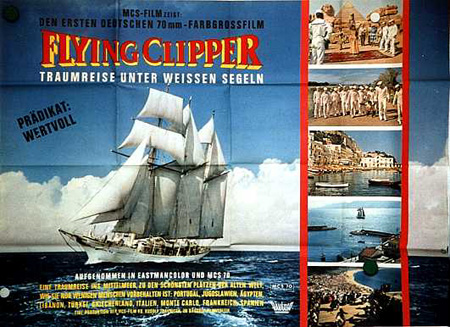New 70mm print of "Flying Clipper" |
Read more
at in70mm.com The 70mm Newsletter |
| Written by: Egbert Koppe Bundesarchiv-Filmarchiv & Barbara Heinrich-Polte Bundesarchiv-Filmarchiv | Date: 06.02.2009 |
 Poster
from Robert
Weidemann's web site about 8mm films. Poster
from Robert
Weidemann's web site about 8mm films.I'm just back from the screening of "The Sound of Music" (Cinestar 8, Potsdamer Platz, began at 7:30pm, ended around 11 pm). I'm sure, you know this film - so, what shall I say?... Anyway - there is a reason why we go to the cinema, to see this beautiful format. But you were asking for the technical background of making the new print of "Flying Clipper". We were (and are) very happy that Jürgen Brückner, some years ago, gave the original negative, plus the black and white separations, and a print (6 track mag), that he had to the Filmarchiv of the Bundesarchiv. It was apparently received just in time: the first signs of vinegar on the negative were visible (and "smellable"), and the print showed the typical fading, losing the blue hues. Climatic conditions in our vaults for color film in Berlin-Wilhelmshagen are minus 6 degree Celsius and 30% relative humidity. That is not enough to stop vinegar syndrome absolutely, but enough to reduce it considerably. In August 2008 Connie Betz from the retrospective team of the Berlinale told me: We would like to have "Flying Clipper" in the program in February 2009, but the existing print is much too faded. Do you think the Bundesarchive might be able to finance a new print? And I answered: We are speaking about a lot of money, and my area of responsibility is only the technical part. But I think we should give more attention to the 70mm heritage in the coming years. And this could be a beginning. Happily, Jürgen Brückner had given us additionally the 35mm 6-track mag master and kindly our administration and our leadership gave the OK to proceed! And - after much negotiation - the Friday before Christmas FOTOKEM got the order to recut the negative (the original had been cut for use on the so-called "Auto Select" printing machines), and to restore the sound (for example, there was some loss, some variation in magnetism, of the audio for the center track), and to produce a DTS70 sound layout and, last but not least, to make a complete DTS70 print. Last Tuesday (Feb. 3) the new print arrived Berlin. First impression was good and tomorrow (Friday) morning we'll check some reels on screen in Cinestar 8, as well as checking the sound layout. Cooperation with FOTOKEM, namely Andrew Oran, was very professional (you know - carrying out these kinds of complex and technical orders day by day, and many specialized decisions have to be made - it's quite a project!) I'm Head of the Technical Department of the Filmarchiv of the Bundesarchiv. Our team, 35 employees, work in the field of examination, manual restoration, cleaning and duplication of movie film. We have our own black and white lab, including some archival printers. I'm not a expert in 70mm film, but I've learned a lot during this project. |
More
in 70mm reading: Berlin 2009 - Programme of Events Complete MCS 70 Superpanorama Films Adverts and posters The M.C.S.-70 Process and European Cinema of the 1960s Traumreisen auf breitem Filmband: Das M.C.S.-70-Verfahren Internet link: Bundesarchiv Tagesspiegel Taz Süddeutsche bundesarchiv.de Bundesarchiv-Filmarchiv 10707 Berlin Fehrbelliner Platz 3 Germany Fon: +49 (0)3018 7770 911 Fax: +49 (0)3018 7770 999 |
Press release |
|
|
Pressemitteilung Berlin, den 3. Februar 2009 Bundesarchiv präsentiert auf der Berlinale 2009 den ersten deutschen 70mm Film in neuer Kopie. Das Bundesarchiv nimmt die Berlinale-Retrospektive „70mm – Bigger than Life“ zum Anlass, um mit „Flying Clipper – Traumreise unter weißen Segeln“ (Hermann Leitner / Rudolf Nussgruber, 1961/62) die erste deutsche Breitfilmproduktion wieder in ihrem originalen Format verfügbar zu machen. 70mm Film, doppelt so breit wie der 35mm Standardfilm, wurde in den 60er und 70er Jahren des letzten Jahrhunderts gern für opulente Landschaftsaufnahmen verwendet, deren exotischem Flair damals noch etwas Besonders anhaftete. Die großformatigen Aufnahmen konnten sich mit ihrer Feinkörnigkeit und Schärfe zeitweise der Konkurrenz des Fernsehens widersetzen und das Erlebnis Kino unterstreichen. Nach Jahrzehnten der unzureichend klimatisierten Lagerung des „Flying Clipper“ - Films hatte das Bundesarchiv leider erst 2001 eine geschrumpfte und rotstichige 70mm Kopie erhalten. Jürgen A. Brückner, 70mm Experte aus Coburg, stellte dem Bundesarchiv 2006 dankenswerter Weise das Originalnegativ zur Verfügung und 2008 die 35mm / 6-Kanalton Magnetfilme. Weltweit sind nur noch wenige Kopier-werke in der Lage, mit diesen Ausgangsmaterialien eine neue Kopie in 70mm Breite herzustellen. Bei dem technisch komplizierten und kostenaufwändigen Prozess war die US-amerikanische Firma Fotokem dem Bundesarchiv ein kompetenter Partner. Anknüpfend an den riesigen Erfolg der wenigen anderen Reisefilme zeigt „Flying Clipper“ die Reise eines schwedischen Segelschulschiffs mit internationaler Besatzung durch das Mittelmeer. Die von dem norwegischen Filmtechniker Jan W. Jacobsen kurz zuvor entwickelte handliche MCS Field Camera erlaubte spektakuläre Panoramaaufnahmen. Die von Heinz Hölscher gedrehten Luftbilder zeigen mediterrane Landschaften, die es heute so nicht mehr gibt. Die brillante 70mm Qualität wird im Rahmen der Berlinale am 11. Februar 2009 in Anwesenheit der Witwe des Produzenten, der deutschen Schauspielerin Hannelore Bollmann-Cantor, Jahrzehnte nach der Uraufführung erneut begeistern. Karl Griep vom Bundesarchiv und Rainer Rother von der Deutschen Kinemathek als Partner der Retrospektive der Berlinale werden in das Programm einführen; Beginn: 22.30 Uhr, Cinestar im Sony Center 8. Kontakt: Egbert Koppe, Tel. 03018/7770-628, bundesarchiv.de |
|
|
Go: back
- top - back issues
- news index Updated 22-01-25 |
|
